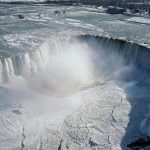
As they ascend the towering cathedral walls, equipped with vacuum cleaner backpacks, the researchers might be mistaken for a team of ghostbusters rather than planetary scientists. Nevertheless, for the dedicated team at the University of Kent, this equipment is essential for a unique mission – collecting cosmic dust that becomes ensnared on ancient cathedral roofs after falling to Earth from space.
Dr. Penny Wozniakiewicz and Dr. Matthias van Ginneken have embarked on a fascinating quest to explore the mysterious world of exotic dust particles. Their goal is to understand the extent to which cosmic material reaches Earth and becomes an integral part of the planet and its atmosphere.
Cathedral roofs prove to be ideal hunting grounds for cosmic dust due to their vast size and limited accessibility. “You want the site as undisturbed as possible,” explains Wozniakiewicz. “The dust is coming in everywhere, but the rooftops offer an opportunity to collect the dust and not have people trampling all over it.”
These captivating dust particles originate from asteroids and comets, hurtling into Earth’s atmosphere at incredible speeds. While many burn up during their fiery journey, some transform into distinctive spheres as they melt and resolidify, scattering across the planet’s surface.
“We want to go to these rooftops because the particles we find are so fascinating. They are useful to get a feel for the number of particles that are arriving at the surface. That can be related back to the number arriving at the top of the atmosphere, so we can learn about the contribution of this material to the Earth,” says Wozniakiewicz.
Encouraged by a successful feasibility study that identified cosmic particles on the roof of Canterbury Cathedral, the scientists are eagerly pressing forward with their mission. They are preparing for a more thorough vacuuming of a larger section of the roof and are planning to visit Rochester Cathedral next.
Despite the winds and rain that sweep away much of the dust, the particles found on the roofs provide valuable insights into the minimum amount of cosmic dust that falls to Earth. Another advantage of cathedral roofs is the meticulous records of construction work, enabling scientists to determine the ages of different roof sections and how long they have accumulated cosmic dust.
“For the next rooftops, it’s important that we collect everything we can get access to over a specified area,” says Wozniakiewicz. Fearless in the face of heights, she adds, “Once I’m up there, I just get on with it and don’t look down.”










Leave a Reply